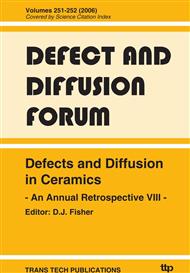p.51
p.59
p.69
p.79
p.89
p.97
p.105
p.111
p.123
Effect of γ-Irradiation on the Mechanical Properties of Al-Cu Alloy
Abstract:
SEM observations and Vickers-hardness tests were performed to identify the irradiation effects. γ- irradiation effect during the aging hardening process can be explained depending on the composition of the alloy and is used to derive quantitative information on the kinetics of the transformation precipitates. Increasing the Cu content of an Al-Cu alloy can improve the aging hardness. The present results of hardness behavior with SEM observations of surveillance specimens at different doses suggest that the radiation-induced defects are probably complex valance-solute clusters. These clusters act as nuclei for the precipitation of θ-Al2Cu type. This can be effectively utilized to study the systematic of nucleation of precipitates at vacancy-type defects. γ-irradiation probably play the key role in defects responsible for material strengthening and embrittlement.
Info:
Periodical:
Pages:
105-110
Citation:
Online since:
March 2006
Authors:
Keywords:
Price:
Сopyright:
© 2006 Trans Tech Publications Ltd. All Rights Reserved
Share:
Citation:


